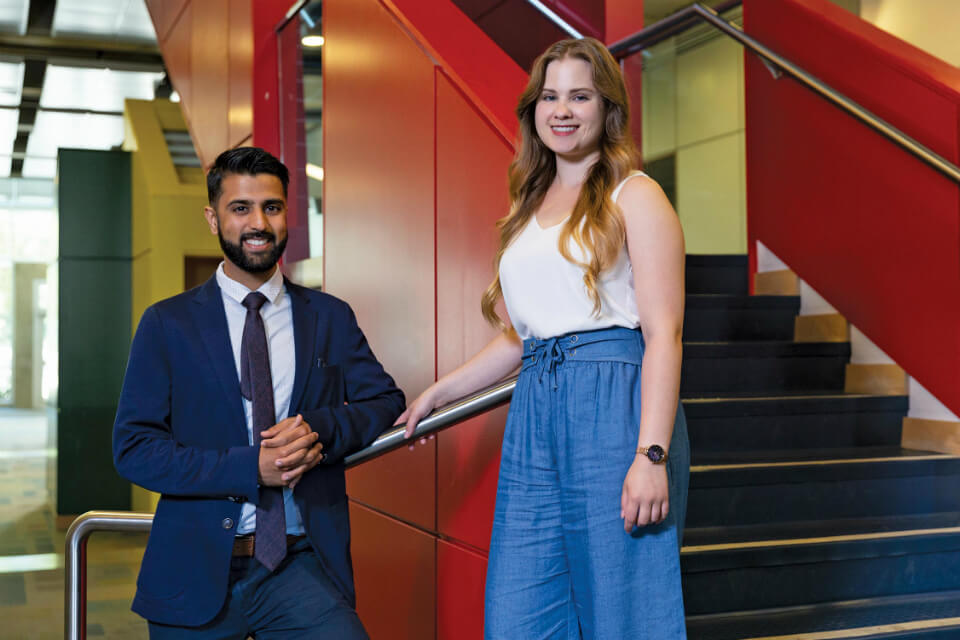A pair of civil engineering grads aim to make artisanal mining safer and more sustainable
Engineering, Science, Graduate Studies
- Suzanne Ahearne

Engineering techniques advancing global sustainability
UVic’s green-focused civil engineering program attracts a lot of pragmatic idealists. Graduates Keri Graumann and Dheeraj Alamchandani are prime examples, using the tools and techniques of engineering as a way to advance social justice and global sustainability.
The pair—from Kelowna, BC and from Jaipur, India, respectively—bonded over a group project they developed into their final engineering design project, which may yet become the focus of one of their master’s work down the road.
As part of Heather Buckley’s greener design course, Graumann and Alamchandani designed a system to reduce mercury contamination arising from the gold-mining practices used in much of the developing world.
“I was driven to be part of the project not only because it involved technical concepts from engineering, chemistry and biology,” recalls Alamchandani, “but because it was about people who don’t have the privilege to use technology for mining.” All the group projects involved finding solutions to toxic mineral remediation but, he says, “this project had the biggest social aspect to it.”
Artisanal gold mining
Around the world, this type of mining is referred to as artisanal gold mining (AGM). The term is a bit misleading. To hipster ears, it sounds like a low-impact, bespoke process—but it’s anything but. Although the method is low-tech and involves very little mechanization, the practice of using mercury to extract gold from ore impacts air and water systems all around the world.
Unlike large-scale gold mines where the precious metal runs in veins, or in rivers where it’s found in flakes or nuggets, this form of mining collects gold dust from ore. Miners, often in family groups, excavate the ore, grind it with a hand mixer, then pour mercury into the ore where it binds with the gold. The mercury- gold amalgam is then heated up, and the mercury vaporizes into the air.
Meanwhile, the remaining ore—the tailings—is dumped out, at which point remnants of mercury enter the water system where it circulates worldwide as precipitation and via ocean currents. As a mining practice, AGM is akin to garbage picking: a ton of ground oremay yield no more than five grams of gold. It’s a common and mostly unregulated practice used in South America, parts of Asia, some African nations and in some rural areas of Europe. AGM provides a livelihood for people with few economic options, but it’s devastating for the environment. The highly toxic element causes vision loss, nervous system breakdown and has a direct correlation with reproductive health. For those involved in the process itself, the effects are more immediate.
Both Graumann and Alamchandani were shocked by what they learned about the widespread environmental and health impacts of AGM—and equally moved by the potential for powerful social justice and environmental change if they could find a solution. They knew that changing policies to stop the process altogether was unrealisticin the short term and their research showed that a number of technology fixes have been tried with mixed success. An immediate harm-reduction solution was needed, combined with policy proposals.
A re-design without mercury
Graumann and Alamchandani, along with their three other team members, used their combined design skills to adapt existing technology—a hydrocyclone which uses centrifugal force to separate particles in a liquid suspension—and proposed it be made of cheap plastic or metal materials. This would make it easy to operate and implement and less likely to upset the economic applecart for subsistence miners. Using the hydrocyclone as an additional step in the process, it would do double duty: it would recover most of the mercury from the ore so it doesn’t enter the water and would enable recovered mercury to be used again, saving miners money. Additional modelling also showed that if the hydrocyclone was used on its own to extract gold without the use of mercury at all, it would recover more gold dust—up to 90% compared to 30 to 70% using the mercury method—potentially making AGM even more profitable.
Then, working in consultation with the Victoria-based Artisanal Gold Council and with Buckley, they advanced their initial work to envision a greener mining infrastructure project at a specific site in Ecuador. Their final capstone project included a tailings pond that uses phytoremediation—a process of extracting toxins from water using plants—that would extract even more mercury. They found several species of local plants that would work.
We believe the final solution should be a combination of both policy and technology to fully encapsulate human health and environmental justice
— Civil Engineering graduate Keri Graumann
“Their integrated approach really embodies what we mean when we talk about green civil engineering,” said Buckley.
How Graumann and Alamchandani’s model will be implemented and accepted by a community is still untested but they said feedback from the Artisanal Gold Council indicated it has a good chance of success. Both graduates plan to work for at least a year or two and then at least one of them may take it up as a master’s project to formally pilot the idea.

